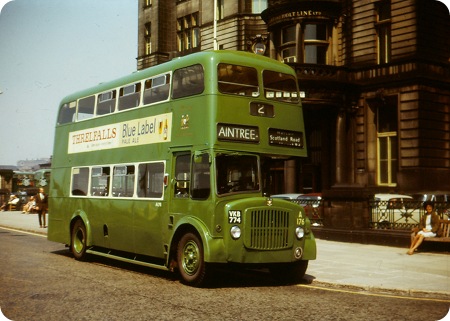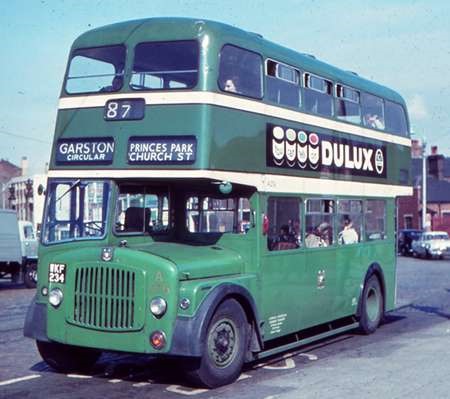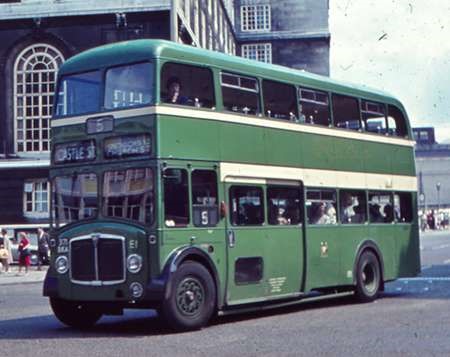Liverpool City Transport – AEC Regent V – VKB 774 – A176
Liverpool City Transport
1957
AEC Regent V
Metro Cammell Weymann H33/29R
A unique radiator grill I think don’t know why as the standard grill looked much better than this tin look. I also think how much better the livery would have been if there was a nice cream band between the upper and lower deck, there was far too much green on Liverpool buses.
Glasgow Corporation also had this tin front on their Regent Vs
Anonymous
The original livery had a cream band right round the bus just above the lower deck windows, and a narrower, similar one below the upper deck windows; the green was also darker. The livery in this picture dates from about 1964 I think.
Anonymous
Some of Aberdeens Gardner engined AEC Regent Vs also sported this type of grille.
Chris Hough
This type of grille was very common in the 1950s on AEC Regents and on Leyland Titans. Known colloquially as a ‘tin front’ the style was common to Regent IIIs and Regent Vs in the Liverpool fleet, 292 of them in all (A1-A292) , and from memory around 300 Titan PD2s. Very common too on Midland Red and Glasgow Corporation ‘deckers.
Anonymous
17/02/11 – 07:08
The ‘City of Liverpool’ name was not added to the coat of arms till 1965.
Anonymous
15/04/15 – 10:43
I remember these well particularly running on routes 4 and 5 from South Castle Street to Woolton, and the 4b and 5b from the Pier Head to Penny Lane. On the 4 and 5 routes, they were able to get up to a fair old speed along the dual carriageways of Menlove Avenue between Penny Lane and Woolton. The 4b and 5b ‘belt’ routes ran out to Penny Lane via Wavertree and Smithdown Road respectively, then changed route number to run back to the city centre the other way, both quite heavily trafficked routes. The Penny Lane terminus was near the ‘shelter in the middle of a roundabout’ made famous in the song, also the terminus of the 99 to Lower Lane, the 42 to Edge Lane, the 71 to South Castle Street, the 77 into town and the 46 to Walton, on which I recall for a while seeing the two single deckers, SL175 and SL176.
Mr Anon
23/01/17 – 16:35
Not strictly about this bus, but the AEC Regent V D3RVs of Liverpool had one similarity to AEC Regent III 9613A A757-806 – the gearbox sound.
Although the A757 etc batch were described as 9613As they had synchromesh gearboxes, and the later batch A1-100 were 9613S. AEC Regent Vs A101-292 and Bridgemaster E3 all sounded the same.
Paul Mason
25/01/17 – 07:32
Herewith the original Liverpool livery on this type – taken at Pier Head on 5/7/1962. At this time the cream only around the windows (to make masking for spray painting quicker, I was told) was already well under way.
It always looked to me that the bottom half of the vehicles were repainted more often than above the lower deck windows.
As an afterthought, I have also included the one and only 30fter AEC in the same livery taken at the Adelphi 26/6/1962.
Geoff Pullin
02/08/20 – 06:43
Where were the handles placed that wound the number and destination scrolls? I remember them as being under the top deck over the front right fender next to the driver’s cab. But on the photos this looks not to be the case.
Gary
03/08/20 – 06:29
I’m not sure about vehicle E1 in particular, but from what I can recall all Liverpool double decks till then had a very robust cast metal destination gear framework that was accessed by the conductor from the front bulkhead of the upper saloon and hinged out so the blinds could be adjusted and seen before being clanged back into place, usually before reaching the terminus.
The subject of changing destination blinds is fascinating in its own right! Even within the much standardised Tilling Group companies, there was no standard! It was surprisingly late in the production of the Lodekka that the double width step appeared in the front cowl instead of two widely spaced single foot holes. The first time was on the six prototype 30ft long vehicles in 1957 and then standardised in the Flat Floor series. Presumably this was to ease access for those companies that had conductor operated blinds. Bristol Tramways/Omnibus itself always used driver operated blinds with controls in the cab roof, so it would not have been imbued in its erstwhile motor constructional works designers as being an operational difficulty!
Geoff Pullin
04/08/20 – 06:38
Geoff’s comment reminded me that the PMT Atlanteans and Fleetlines 1959-1965 had a similar destination layout which the conductor changed from the top deck by hinging the unit towards him so that the destination could be set before pushing the unit back into the vertical position. These were the first double decks with separate main and via blinds.
Ian Wild
05/08/20 – 06:47
Similar on some of Trent’s vehicles. I remember heading into Nottingham with my parents one evening about 1956 (I’d be 7). Front seat upstairs on one of the pre-war Willowbrook re-bodied Regents. Conductor came upstairs, unlatched the display before my wondering eyes, turned to me and said, "Right – you wind that handle right to the end…"
Stephen Ford
20/08/20 – 05:33
Geoff Pullin comments about being unsure whether E1 had the hinged blind box of its predecessors. In fact this feature continued on the Atlanteans of the L500-L801 (at least) series which were delivered with the three-window layout. It was only with the introduction of OPO that the simplified layout with just number and terminal displays was incorporated, which could be operated from the driver’s seat.
Alan Murray-Rust
Quick links to the - Comments Page - Contact Page - Home Page
Comments - Please note: The comments facility is not currently available. Please see the home page for updates.
Please Note if you want to send a photograph with your comment please use the Contact Page by clicking here or send as an attachment via email.



